Subtotal: $
Checkout-

A Good Death
-

Behold the Glory of Pigs
-

Polyface Logic
-

Nature Is Sacred Stuff
-

Editors’ Picks Issue 10
-

Poem: An Apology for Vivian
-

Stewarding Mercy
-

Learning to Love Goodness
-

Who Invented Thirst and Water?
-

Muhammad Ali
-

Are Humans Sacred?
-

Islands
-

Readers Respond Issue 10
-

Consistent Life Network
-

Death Knell for Just War
-

Remembering Daniel Berrigan
-

My Return to Iraq
-

Pursuing Happiness
-

The Gospel of Life
-

Building the Jesus Movement
-

Behind Prison Walls
-

Womb to Tomb
-

Insights on the Gospel of Life
-

A World Where Abortion Is Unthinkable

Next Article:
Explore Other Articles:
Guns are tools, right? Police and soldiers use them to do their jobs, and many citizens feel safer with one strapped on. In the United States, the only country with more guns than people, it’s no surprise that these weapons feature daily in the news: from terror attacks and mass shootings to the less publicized but more widespread epidemics of handgun violence, suicide, and accidental shootings by children.
Turn War Around
The Second Amendment enshrines a distinctly American – and, some would say, sacred – freedom: the right to bear arms. How to reconcile that with the need to curb gun violence? Michael Martin, a young Mennonite from Colorado Springs, decided the best way to approach this emotionally charged issue was to tell a different story – to counter the debilitating stream of tragic news with an alternative narrative of transformation and restoration, one tool at a time.
Martin won’t take away your rights, but if you happen to have a gun you want to be rid of, he’ll be happy to forge it into a garden tool for you.

Already a subscriber? Sign in
Try 3 months of unlimited access. Start your FREE TRIAL today. Cancel anytime.
The idea hatched back in 2009 as Martin watched news coverage of the christening of the USS New York, a battleship with a bow stem made of steel from the fallen World Trade Center. (“Notice how they bring Christ into it.”) Someone needed to counteract this rhetoric and symbolism of revenge, Martin felt. A big fan of Walter Brueggemann’s approach to the Old Testament, he latched onto Isaiah’s words, “They shall beat their swords into plowshares and their spears into pruning hooks.” The prophet Micah repeats this refrain and adds, “They shall all sit under their own vines and under their own fig trees, and no one shall make them afraid.” So, repurposing weapons to grow food as a way to drive out fear. “That’s our end goal: to get to the point where we’re not afraid of each other anymore.”

World Trade Center steel is forged into a warship.
It wasn’t until Adam Lanza opened fire at Sandy Hook Elementary School in 2012, killing twenty children and six adults, that Martin knew he needed to act. His wife, Hannah, suggested they call their project RAWtools. (“You get RAW when you turn WAR around.”) “Alongside the destructive narratives that the guns come out of, we want to share the creation narratives that have been born out of those – stories and pictures of the beautiful gardens and food being grown with the tools.”
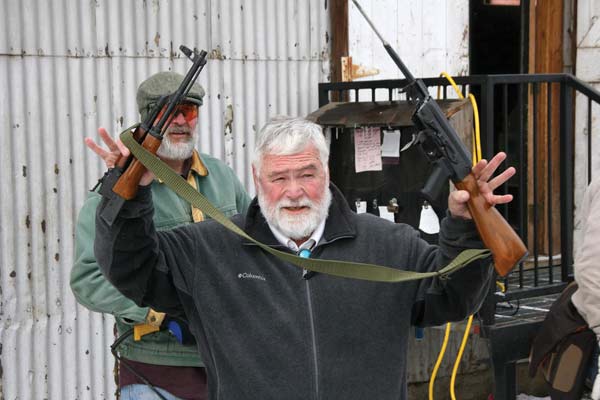
Mike Warren
Thank God I’m Free

Mike Warren, a sixty-four-year-old former infantry soldier, provided the first weapon: an AK-47 assault rifle he acquired in the days after the September 11 terror attacks. “I was afraid,” he admitted. According to the Colorado Springs Gazette, Warren, a sportsman who says he has no plans to dispose of his hunting guns, said the last straw for his assault rifle was the massacre at Sandy Hook. Warren’s weapon was cut in half with an angle grinder. Holding the severed assault rifle high in the air, he said, “Thank God I’m free of the damn thing.” Warren said he did not want to make a political statement: “I speak for nobody but myself.”
A local rancher, Terry Brown, taught Martin and his father, Fred, to form the barrel into hand cultivators. Brown owns about thirty guns, which he says he needs to do his job – “to put an injured horse out of its misery, for example.” Still, he thinks RAWtools is a good idea, and says he would never point a gun at another human being. “That’s where I draw the line. Animals, yes; people, no.”
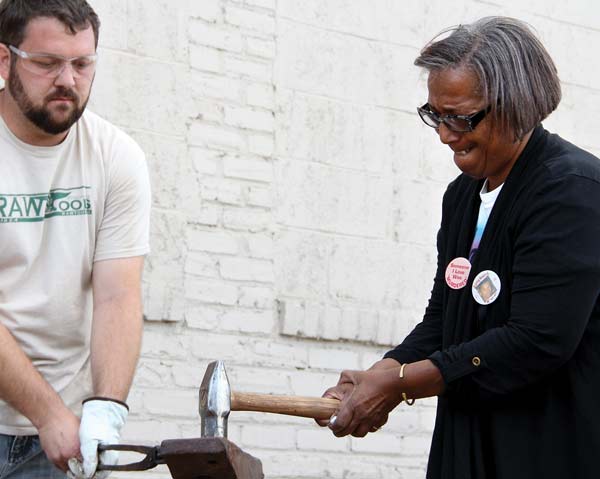
Cherie Ryans
For My Son
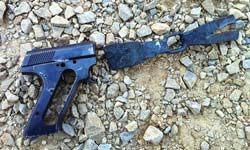
Cherie Ryans lost her eighteen-year-old son Terence, a college student studying criminal justice, when bullets intended for someone else struck him as he left a movie theater in Philadelphia. Fifteen years later, RAWtools set up their anvil in the city and invited parents who had lost children to gun violence to beat on the barrel of a handgun (smaller photo) that had been removed from the streets. As tears streamed down her face, Ryans said slowly and forcefully, pounding the red-hot metal after every word, “This – is – for – my – son.”
Martin says, “It really helped her release in a physical way a lot of the anguish that she dealt with. It helped us see what he meant to her, but also that fifteen years removed from the incident, there was still deep, deep pain.” Martin finds that women, especially mothers, are leading the movement to end gun violence: “They want to heal the world.”
The tool, with a small hoe on one side and a two-prong tilling fork on the other, has been used to plant flowers for victims of gun violence in the Philadelphia area.
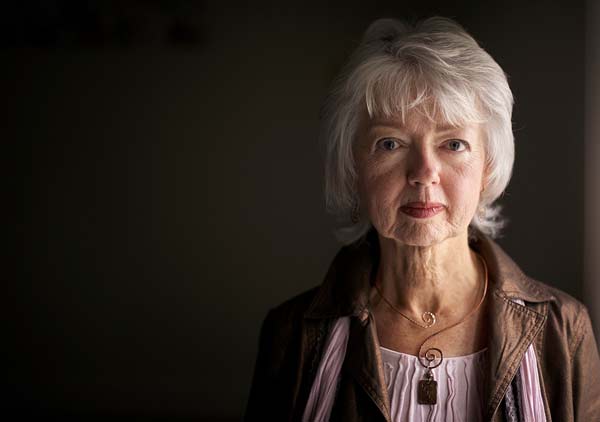
Terri Roberts
Their Love Melted Me
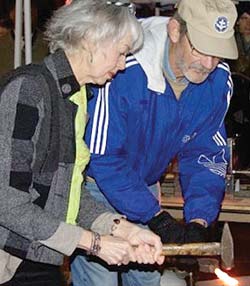
Terri Roberts takes a hammer to the barrel of a gun during a RAWtools demonstration.
Perpetrators’ families also suffer from gun violence. Terri Roberts is the mother of Charles Roberts IV, who ten years ago took Amish schoolgirls hostage in their one-room schoolhouse in Nickel Mines, Pennsylvania. He shot ten of the girls, killing five, before turning the gun on himself.
Within twenty-four hours the Amish families were at Terri’s door, reaching out to her and her husband. Their love melted her. Over the years since the shooting, Terri has continued to develop a relationship with the victims’ families. Every other Thursday, she visits one of the survivors, Rosanna, who still uses a wheelchair and eats with a feeding tube. Terri helps Rosanna bathe and reads or sings with her. Spending time together has helped both of them heal. Every time Terri visits, she is confronted with the damage her son caused. But she is also reminded that violence need not have the last word. Terri recounts her journey in a book titled Forgiven.
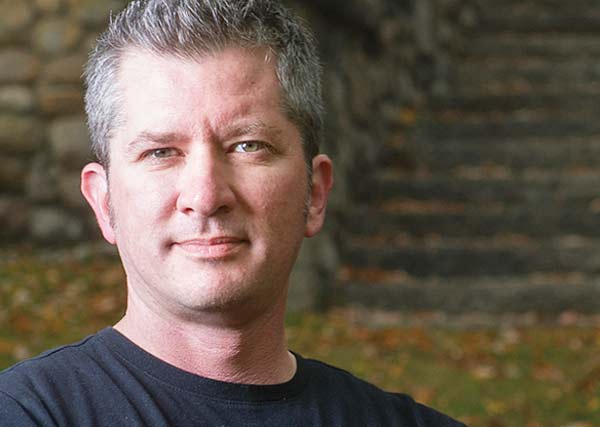
Benjamin L. Corey
I Wanted to Die
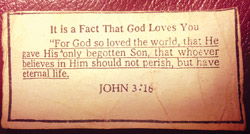
The note that saved Benjamin Corey’s life.
Eleven years ago, a twenty-seven-year-old unemployed military veteran named Benjamin L. Corey was “broke, alone, divorcing, and about as clinically depressed as a person could get.” He saw no reason to go on living, so he loaded his Smith & Wesson .22 and tried to work up courage to pull the trigger. On a quick run to the store to “grab something to drink and take the edge off before coming home to finish the job once and for all,” he silently told God, “If you really love me, I need to know right now.” In the store, a passing stranger put a note in his hand that saved his life (a story he recounts in detail on his Patheos blog).
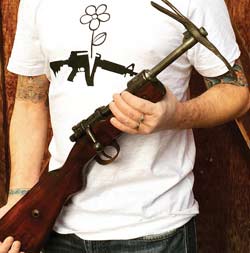
The World War II Mauser donated by Corey.
Last summer Corey planted a garden with a tool made from his .22.
Suicide accounts for more than 60 percent of gun violence, and about 85 percent of those deaths are white males. Afterward, the family is often left wondering what to do with the gun. When Kevin Wilder was eight years old, his father shot himself. Forty years later, Wilder donated the gun to RAWtools. “I’ve had the gun all this time,” he said. “I couldn’t give it to somebody else.”
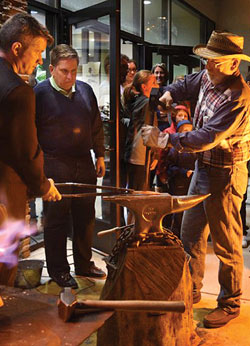
Benjamin Corey helps RAWtools repurpose Kevin Wilder’s gun, as shooting survivor David Works looks on.
Photo Jerilee Bennett © Colorado Springs Gazette
Corey also donated a World War II Mauser. In one photo, he helps RAWtools repurpose Kevin Wilder’s gun, as shooting survivor David Works looks on. In 2007 Works and his family were shot in the parking lot of New Life Church in Colorado Springs. “To make a long story short, I started the day with four kids and I ended it with two.” The gunman sprayed the family’s minivan with bullets, killing teenage daughters Stephanie and Rachel. Less than a month later, the church’s pastor asked Works and his wife Marie if they would be willing to meet the parents of the man who shot their daughters. The families met and have stayed in touch.
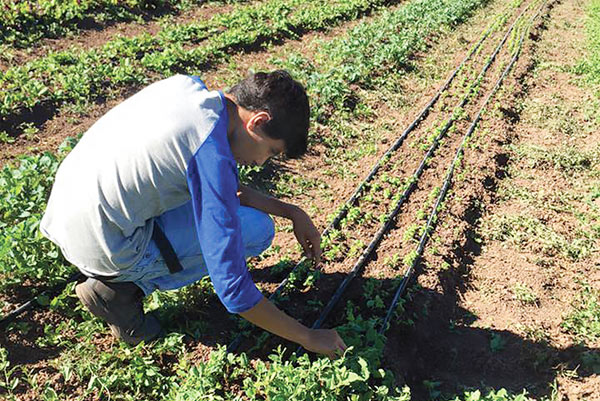
The garden at La Plazita Institute.
Vegetables for Young Offenders
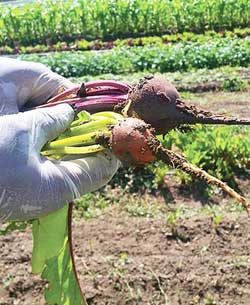
“Why do our kids pick up sticks and turn them into guns?” Martin asks. “We’ve got a lot of work to do: when two-year-olds pretend a stick is a gun, we know that our imaginations have gone down the wrong road. Why can’t they use the sticks to make a teepee or something?”
La Plazita Institute in Albuquerque draws on Native American practices and culture to help at-risk Native American and Latino youth, many of whom have already been in gangs and jail. This summer RAWtools helped the youth convert guns confiscated by Albuquerque police into garden tools. The youth are now using the tools in organic gardens that supply local public schools and the detention centers that house many of the young gardeners’ peers. “It’s a beautiful full circle of reconciliation and reintegration and restoration,” says Martin. “That’s what we’re about.”
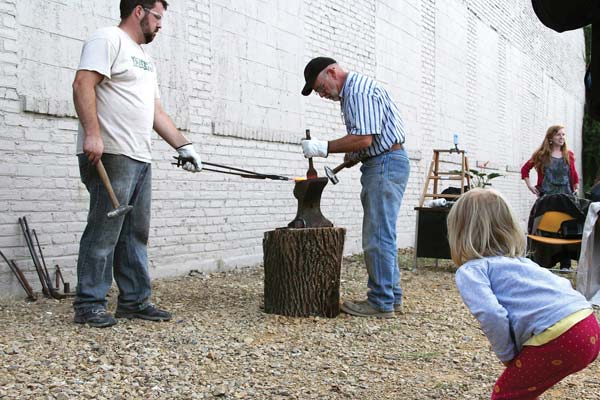
Michael Martin works on transforming a gun into a tool.
What’s Next?
Martin wants to try melting the aluminum in guns to form knitting needles, which will be used to empower women in Afghanistan to earn their living. He’d also like to see affiliates in every state, because of the restrictions on shipping guns across state lines.
“But converting guns has been the easy part,” he says. “The hard part is the human element and changing the way we deal with conflict. Turning guns into garden tools points us to what we need to do with ourselves; it compels us to use our imaginations to look at the other tools that are out there, like mediation, talking circles, restorative justice, and anti-bullying programs.
“I see us as that hot metal: if we allow ourselves to be vulnerable to the heat of confrontation, then the cold steel of the anvil and the hammer – the work of the community and the work of the Spirit – can shape us. It’s the hot steel – or the hothead – that is at its most impressionable, so when we have cool voices around us, or maybe the whisper of the Spirit, that can help shape us into better witnesses to Christ.”
To donate guns or purchase tools, see rawtools.org. For more on Americans’ devotion to guns, read America and Its Guns: A Theological Exposé, by James E. Atwood (Wipf & Stock, 2012).
Already a subscriber? Sign in
Try 3 months of unlimited access. Start your FREE TRIAL today. Cancel anytime.



































Mike
Turning guns into garden tools is nice and feels good but it does nothing to solve the real problem. The problem isn't the gun (the tool), it is the condition of the heart.
Erna Albertz, Plough.com
Thank you for reading this article. Michael Martin, the founder of RAWtools, says, “converting guns has been the easy part. The hard part is the human element and changing the way we deal with conflict.” Do you agree? In what other ways could we change how we as a society deal with conflict?